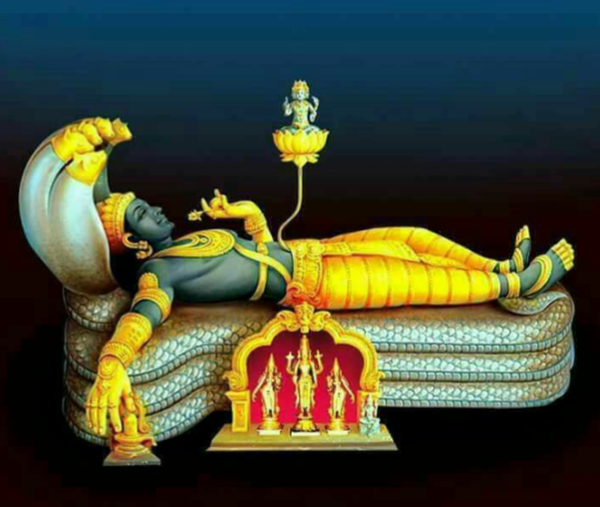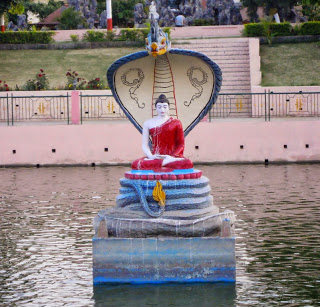In Hinduism, Lord Vishnu is widely regarded as the Supreme Creator. In religious iconography he is shown reclining on the coils of a gigantic, seven-hooded serpent called Ananta-Sesha, in the middle of the cosmic milky ocean.
Both Vishnu and Ananta-Sesha and are eternally present through the periodic cosmic cycles of creation and destruction.
The Vishnu Purana states that at the end of a “Day of Brahma”, when the entire creation has been dissolved, and the world has been converted into one vast ocean, “the Supreme reposes upon his mighty serpent couch amidst the deep: he awakes after a season, and again, as Brahma, becomes the author of creation.”
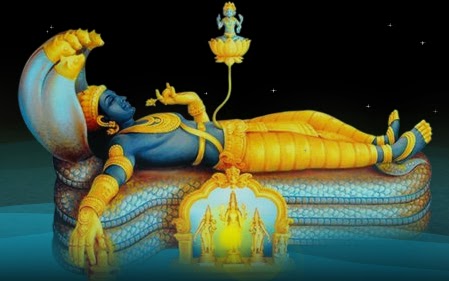
The iconography of Vishnu also shows a lotus flower emerging from the navel of Vishnu (Vishnu-nabhi), on which is seated Brahma who brings forth the material creation. Hence, Vishnu is described as “lotus-navelled” (padma-nabha); and Brahma is termed the “navel-born” (nabhija). There are many other gods and goddesses of Hinduism, Buddhism and of Egypt, who are regarded as “Lotus-born” and are shown standing or seated on the lotus and /or wearing lotus-crowns.
Hence, Vishnu is described as “lotus-navelled” (padma-nabha); and Brahma is termed the “navel-born” (nabhija). There are many other gods and goddesses of Hinduism, Buddhism and of Egypt, who are regarded as “Lotus-born” and are shown standing or seated on the lotus and /or wearing lotus-crowns.
As per the Puranas, however, what emerges from the navel of Vishnu is not the stalk of the lotus flower, but the lotus “seed-pod”, which is symbolically equivalent to the golden Mount Meru, the axis-mundi of the universe. Mount Meru is the abode of the gods and on top of Meru are present the palaces of Brahma and the protectors of the eight directions.
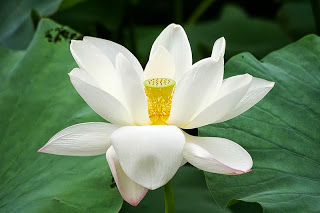
Although, the symbolic depiction of Vishnu in Hinduism is considered to be quite unique, we can find similar images in many other religions as well. This suggests the possibility that the symbolism of Vishnu was well-known to many of the ancient cultures of the world. We will begin by looking at three architectural pieces from Mesoamerica.
Mesoamerica
One of the first complex civilizations of Mesoamerica were the Olmecs, who appeared around c.1600 BCE, and are regarded as a “mother culture” to subsequent Mesoamerican cultures. A very early Olmec carving from c.800 BCE depicts a god or a priest, seated in the coils of a powerful serpent.

The serpent was worshipped as a powerful symbol of creation all over Mesoamerica, just as Ananta-Sesha was also worshipped in India. The god within the serpent seems to be holding a “bucket” in one hand, which is probably a container of powdered copal – used in Mexico as incense. It is considered to be the odor of sacrifice, and a fragrance pleasing to the gods.
In the Mythic Image, Joseph Campbell observes that:
”the left hand of this seated figure is held somewhat awkwardly (as remarked by the archaeologists-discoverers, “turned at the wrist with the palm out”), in a gesture that in the Orient would be everywhere interpreted as the “boon-bestowing hand posture” (varada-mudra) of a divinity; and the fact that the Olmec artist even over-strained his art to render it in the profile of his relief suggests that the gesture must have had some such ritual meaning in the Middle America as well”.
The symbolic and visual similarities of this carving with the iconography of Vishnu are quite apparent. Was this a representation of Vishnu amongst the ancient Olmecs? We probably need some more evidence before we can state that with certainty.
The second artifact from Mesoamerica that we will look at is the sarcophagus lid of the Classic-era Maya ruler of Palenque, K’inich Janaab’ Pakal (683 CE), also known as “Lord Pacal” or “Pacal the Great”. This is a monumental piece of stone sculpture, and is regarded as a unique piece of Classic Period (c. 250 CE – 900 CE) Maya art. Although visitors are now prohibited from entering the tomb of Pacal in the “Temple of the Inscriptions” at Palenque, a replica of the stone sarcophagus is kept at the National Museum of Anthropology in Mexico City, which I had been fortunate enough to view.

Mesoamerican scholars are in agreement that the carving shows Lord Pacal in a reclining position, and above him is the Maya World Tree on which is perched a great bird, Itzam-Yeh. The World Tree (Wakah-Chan) was the symbolic axis-mundi among the Mayans, which connects the 9 levels of the Underworld with the 13 levels of Heaven and the terrestrial realm. It is symbolically equivalent to the Mount Meru, for the tree and the mountain were both used interchangeably by most ancient cultures to refer to the central axis of the world.
Beneath Pacal is “one of the heads of a celestial two-headed serpent viewed frontally”. Thus all the key elements of the Vishnu symbolism are present in this carving – the reclining deity, the World Tree and the serpent. The king is shown wearing a “turtle ornament” on the breast, which is again very interesting for Lord Vishnu had taken the form of a turtle during the churning of the milky ocean. And around the edges of the lid is a band with cosmological signs, including those for sun, moon, and the stars, which indicates that the entire image is set in the heavens, and is therefore a cosmic representation of Lord Pacal, who has ascended to the heavens.
It is clear from the symbolisms associated with this image that it is most definitely depicting Lord Pacal in the form of Vishnu, reclining on the serpent in the cosmic ocean, with the World Tree emerging from his body.
The third and final architectural piece from Mesoamerica that we will look at is the stone statue of Chac-Mool which has been found in many Mayan sites, throughout Central Mexico and the Yucatan peninsula. The term Chac-Mool was coined by Augustus Le Plongeon, who had excavated one of the statues at Chichen Itza in 1875. We do not know by what name the Mayans referred to this statue, and what it represents.
There are a couple of statues of Chac-Mool on display at the National Museum of Anthropology in Mexico City, both of which show close similarities with the iconography of Vishnu. The first statue depicts a human figure in a reclining position, with the head turned to one side, and in the center of the stomach there is a circular depression. When I had first seen this statue, it appeared as though the circular depression may have been a receptacle for a stone pillar or some similar object.
The second statue confirmed this suspicion. It shows an elaborately decorated version of the Chac-Mool with ornate headdress and necklace, which was recovered from the Templo Mayor (Main Temple) of the Aztecs at their capital city Tenochtitlan (modern day Mexico City) . He is holding onto a circular pillar-like object, which no doubt is attached to the circular receptacle on his stomach. What this pillar-like object represents is anybody’s guess. Some scholars believe that this could be a vessel or a vase. However, given the fact that this “pillar” arises from his navel, it is possible that it represents the cosmic mountain, the symbolic axis-mundi of the world, or its symbolic equivalent – the lotus seed-pod.

Zelia Nuttall of the Harvard University has pointed out a number of interesting points with respect to this statue, which supports the identification with Vishnu.
He states that the “under surface of its base is entirely covered with zigzag water lines and representations of roots of plants…shells…and frogs which are intimately associated with water symbolism.” This means that the statue was depicted as “floating on water”, just as Vishnu rests on the waters of the cosmic ocean, for which he is also known as Narayana – “the Spirit moving on the waters.”
Zelia Nuttall also observes that the statue was associated with fertility, which “is symbolized by the wreath of ears of corn and reeds (Nahuatl, tollin) which is sculptured around the base”. A similar statue on the summit of the Great Temple in Tenochtitlan “held a collection of all the seeds of the land”, while a recumbent idol in the city of Tula received regular offerings from sterile women, praying for fertility. This agrees well with the lotus symbolism, since the lotus flower, in particular the lotus seed-pod which contains the tiny lotus seeds with fully-formed petals, was also regarded as a symbol of fertility throughout the ancient world.
The Chac-Mool can also be seen at the famous Mayan site of Chichen Itza, another important site I had the good fortune of visiting. It is clearly visible at the end of a flight of stairs which leads to the top of a large, flat-topped pyramid called “The Temple of the Warriors”. Chichen Itza was one of the largest Mayan cities of the Classic Period, and for Chac-Mool to have been given such prominence at this famous site implies that he must have been a highly revered deity.
John Major Jenkins mentions in his book Galactic Alignment (p 39), that the North Temple at Chichen Itza has a very interesting mural depicted on the lowest level, “where a huge deity lies prostrate with vines growing from its belly. Directly above the navel manifestation,on the second level, we see an unoccupied throne. It is difficult not to think of the Hindu deity Vishnu, who manifested the universe from his navel.”
Zelia Nutall, in his analysis of the Chac-Mool statue, came to this interesting conclusion:
“The inference to be drawn from the foregoing data is that the Mexicans and the Mayas habitually kept, on the summit of their principal temple, in their centres of government, a statue holding a circular vessel and figuratively representing the “navel or centre of the land.”…on this consecrated spot, which emblematized the source whence all life proceeded, sacred emblematic rites were performed, the purpose of which was to typify the union, in the centre, of the four elements requisite for the productiveness of the earth.”
The association of the Chac-Mool with the “navel or center of the land”, and honor paid to him as “the source whence all life proceeded” establishes quite conclusively that it must have been the symbolic equivalent of Vishnu. Vishnu, too, is regarded as the source of creation, reclining in the middle of the cosmic ocean, and his navel, which is known as Vishnunabhi, is the point of emanation of the cosmos.
Egypt
In Egypt, the primary deities of worship at Heliopolis since the beginning of the Old Kingdom (c. 2649 BCE) were a group of nine deities, which was collectively referred to by the Greeks as the Ennead. The head of the Ennead was Atum, the self-created deity and the Supreme Creator; he was the first to have emerged from the infinite waters of the primeval ocean, and he brought forth the gods and human beings.
There are many hymns dedicated to Atum in the Pyramid Texts and the Coffin Texts which demonstrate the close symbolic similarities to Vishnu. Just like Vishnu, Atum was also encircled by the coils of the serpent. In a recitation of the First Intermediate Period the “Universal Master” i.e. Atum explains to the gods that he thought of the four basic laws of creation “while I was still in the midst of the serpent coil.”[iv] A similar motif is expressed in a hymn from the Coffin Texts in which the serpent exclaims that his coils delimit creation and the Creator Atum, the “Indwelling Soul of all creatures”, was the “One who made a place for himself in the midst of his coils.”[v] The striking similarity with the Vishnu symbolism is plainly apparent here.
Just like Ananta-Sesha, this “serpent of the deep” was also regarded as a primeval force of creation in Egypt, and it existed since the beginning of creation. It was known in many places as Sito, “Son of the Earth” or Iru-To, “Creator of the Earth”. It was a “monstrous serpent who took form as Iru-To, arising out of the darkness of the primeval waters before any definite thing yet existed.” The “serpent with tail in its mouth forming a circle” was an Egyptian symbol of eternity and immortality. This Egyptian symbol was later known as the Ouroboros or the “tail-devourer” in ancient Greece and became a popular alchemical symbol which came to symbolize the cyclic nature of the universe.
In the ancient Indian texts, the serpent Ananta-Sesha, on whose coils Vishnu rests, is sometimes regarded as a manifestation of Vishnu himself. The same belief was also present in ancient Egypt, for in a hymn from the Pyramid Texts Atum explicitly identifies himself with the primeval serpent with its many coils.
“I am the outflow of the Primeval Flood,
He who emerged from the waters.
I am the “Provider of Attributes” serpent with its many coils,
I am the Scribe of the Divine Book
Which says what has been and effects what is yet to be”
The Vedic belief in successive cycles of cosmic creation and dissolution also finds an echo in the Egyptian texts. In the Book of the Dead we find the prophecy that when the world returns to its original watery chaos, the hidden aspect of the supreme god, Atum, will become the new serpent – “that great surviving serpent, when all mankind has reverted to the slime”
“Then I will be what will remain,
Just I and Osiris,
When I will have changed myself back into the Old Serpent
Who knew no man and saw no god.”
Thus, just as Vishnu reposes on his “mighty serpent couch” after the dissolution of the world, Atum too “transforms” himself into the “great surviving serpent”, after the world has returned to the original watery chaos.
Christianity
In various forms of Christian art – stained glass windows, illuminated manuscripts, wall paintings, architectural carvings, embroidery etc. – the Tree of Jesse is depicted. Jesse or Yishai is the father of the Biblical King David. In the representation of the Tree, it is usual for Jesse to be portrayed as lying down with a tree rising from his body, specifically from his navel, and the ancestors of Christ portrayed in its branches, with the Christ at the summit. Jesse is usually shown reclining, with his eyes closed, and his head propped up by his hand, in a manner reminiscent of Vishnu. In this symbolism, Christ is regarded as the “shoot of Jesse”, since his genealogy is traced back King David, the son of Jesse, in Matthew’s Gospel.
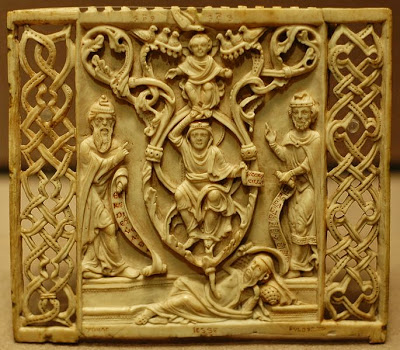
The symbolism of the Tree of Jesse is believed to have originated in Northern Europe where it was most popular. It is very likely, therefore, the Tree of Jesse was derived from the concept of the World Tree Yggdrasil which was the central axis of the world in Norse mythology. This cosmic tree was believed to be located at the center of the earth, and it reached upto the heavens, with its roots in the underworld. It was the fulcrum of the world, around which everything revolved. Just like the Mayan World Tree, a great eagle was perched on top of the Yggdrasil. Hilda Ellis Davidson observes that, “The conception of the tree rising through a number of worlds is found in northern Eurasia and forms part of the shamanic lore shared by many peoples of this region
The World Tree was assimilated into the Christian lore, for The Book of Daniel mentions: “Thus were the visions of mine head in my bed; I saw, and behold a tree in the midst of the earth, and the height thereof was great. The tree grew, and was strong, and the height thereof reached unto heaven, and the sight thereof to the end of all the earth.”(Daniel 4:10-11)
The oldest known Jesse Tree window at the Chartres Cathedral, France (c.1145 CE) shows the tree with seven levBasilique Saint-Quentin, France. The Tree of Life emerging from the navel of Jesse, with Jesus shown on top of the tree. Source: Wikipedia els, which was certainly derived from the idea of the seven levels of heaven and the seven levels of the cosmic mountain, which was built into the art, architecture and literary traditions of many ancient cultures.
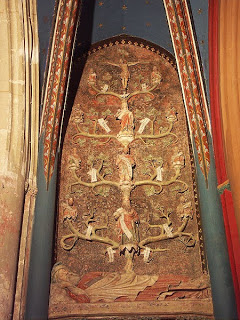
The emergence of the World Tree from the navel of Jesse is, therefore, symbolically equivalent to the emergence of the Mount Meru from the navel of Vishnu. According to the Bible, Jesse had as many as eight sons, which is interesting, since the Egyptian Ennead, excluding Atum the Creator, had eight gods all of whom proceeded from Atum. Jesse thus becomes the symbolic equivalent of Vishnu and Atum. Jesus, who is shown on top of the Tree, often surrounded by seven doves (probably representing the seven stars of the Pleiades or the Seven Sages) can be equated, in this symbolic context, with Brahma, who sits on top of the Mount Meru.
A similar observation had been made by Joseph Campbell: “A Christian counterpart of the World Lotus growing from Vishnu’s navel will be recognized in the tree of Jesse…Jesus as the culminating blossom of the Tree of Jesse is a homologue of the Buddha seated on the lotus.”
Buddhism
Buddhism had emerged out of India, and had quite naturally adopted many of the symbols of Hinduism. Therefore, it is not surprising to find the symbolism of Vishnu associated with the Buddha. At Bodh Gaya, where the Buddha had attained enlightenment sitting under a Bodhi Tree, there is a statue of the Buddha seated within the coils of the Mucalinda serpent, in the center of a large lake.
According to the Buddhist texts, after attaining enlightenment, the Buddha spent seven more weeks in meditation at seven different places near the Bodhi Tree. Lord Buddha spent the sixth week after his enlightenment in meditation at the foot of the Mucalinda Tree. While he was meditating a severe thunderstorm broke out, and the Mucalinda serpent emerged from his underground lair and wrapped himself around the Buddha and protected him from the storm. A large lake was subsequently built at this spot and a statue of the Buddha was installed in the center of the lake. Once again, the visual similarity to the iconography of Vishnu is obvious.
Conclusion
We can conclude that the symbolism of Vishu, resting in the coils of the serpent Ananta-Sesha, in the middle of the cosmic ocean, with the lotus seed-pod or the Mount Meru emerging from his navel, can be found in widely dispersed cultures. It should be remembered that Vishnu has various other manifestations and avatars which may have their own symbolic equivalents in other cultures. However, the focus of this study is primarily on the main iconographical representation of Vishnu.
It is possible that the widespread prevalence of this iconography was, in some cases, influenced by cultural contacts between Hinduism and other civilizations, or through a process of cultural diffusion due to migration. However, it is also likely that this symbolism reflects a shared understanding of the cosmos that was present amongst the ancient societies, but has now been forgotten. We do not understand what this symbolism means, or how this cosmic vision evolved. However, its acceptance and usage by many ancient traditions cannot be doubted.
Author: Bibhu Dev Misra
Image Courtesy:PicsWe
You may also like
-
India Can’t Afford to Remain Stagnant at this Juncture, Says PM Modi; Asks People to Buy Locally-Made Goods
-
Stolen Artefacts to be Returned to India from Scotland Museums
-
Legendary Singer Lata Mangeshkar Passes Away At the Age of 92
-
Netaji’s Hologram Statue at India Gate
-
10th Century Stone Idol of Goat Head Yogini IllegallyRemoved from A Temple in Lokhari, Banda, UP Being Returned to India
